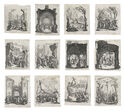
19th, 20th & 21st Century Fine Prints
707-546-7352 · fax 707-546-7924 · web: www.annexgalleries.com · email: artannex@aol.com
Jacques Callot Biography
Jacques Callot
French
1592–1653
Biography
French etcher and engraver Jacques Callot was born in Nancy, Duchy of Lorraine (then not yet a part of France) in 1592. He would become known as one of the first artists to focus solely on the printmaking medium, and one whose sociopolitical and religious suites would remain widely influential for generations to come. Born into court life, his father was Herald-at-Arms to the Duke of Lorraine and a member of his bodyguard of archers. As such, Callot was exposed to the arts from an early age. In 1606 he was given private instruction in drawing and painting from court painter Claude Henriet, and apprencticed with silversmith and engraver Demenge Crocq.
Around 1609 Callot is recorded to have arrived in Rome, where he apprenticed with engraver and publisher Philippe Thomassin and received further support and instruction from printmakers Francesco Villamena and Antonio Tempesta. In 1912 Tempesta secured Callot a position as one of the artists to produce a funereal book of the Queen of Spain, Margherita of Austria. These would become his first published etchings. This led to a position in service of the Medici family in Florence, working with artist Giulio Parigi to record celebratory court events.
After his return to Nancy in 1621, his reputation as a court-appointed etcher and engraver preceded him and led to several large commissions from prominent European figures, including Charles IV of Lorraine; Infante Isabella of the Netherlands; and Louis the XIII. Additionally, Callow built a portfolio of his own works, often having to do with his views on war and religion. Among his most famous works is the Grand Miseres et les Malheurs de la guerre cycle from 1633, a commentary on the horrors of warfare as he observed during the Thirty Years' War with the occupation of Nancy by Cardinal Richelieu's army. It is considered the first outwardly anti-war suite to have ever been published. It would greatly influence many artists in the future, including Goya and his now well-known suite Los desastres de la guerre; indeed, Goya kept a complete set of Callot's cycle in his studio.
Callot remained in Nancy from 1630 until his death from a long illness in 1635. Currently, his works are held in important collections and museums throughout the world.



